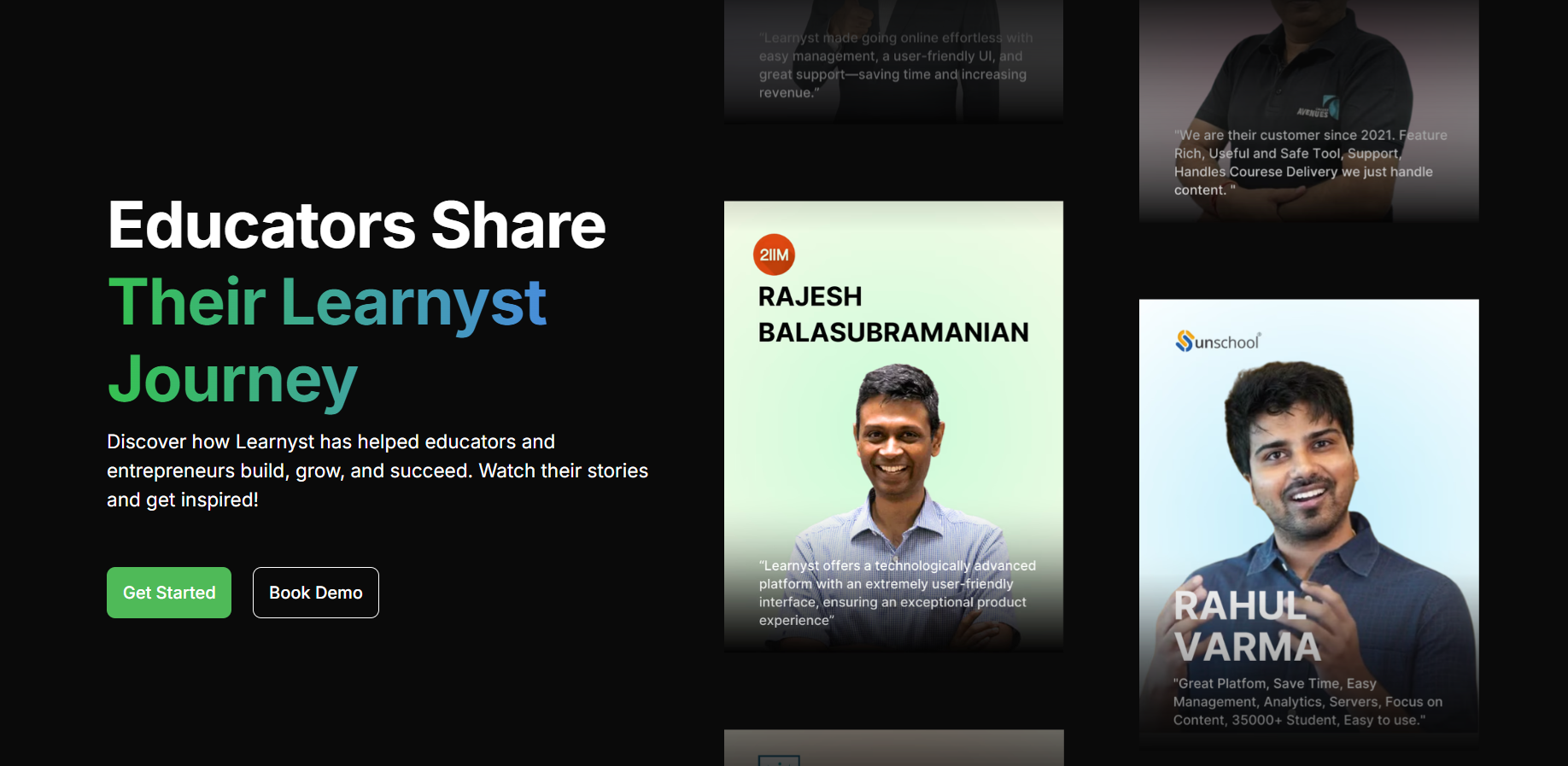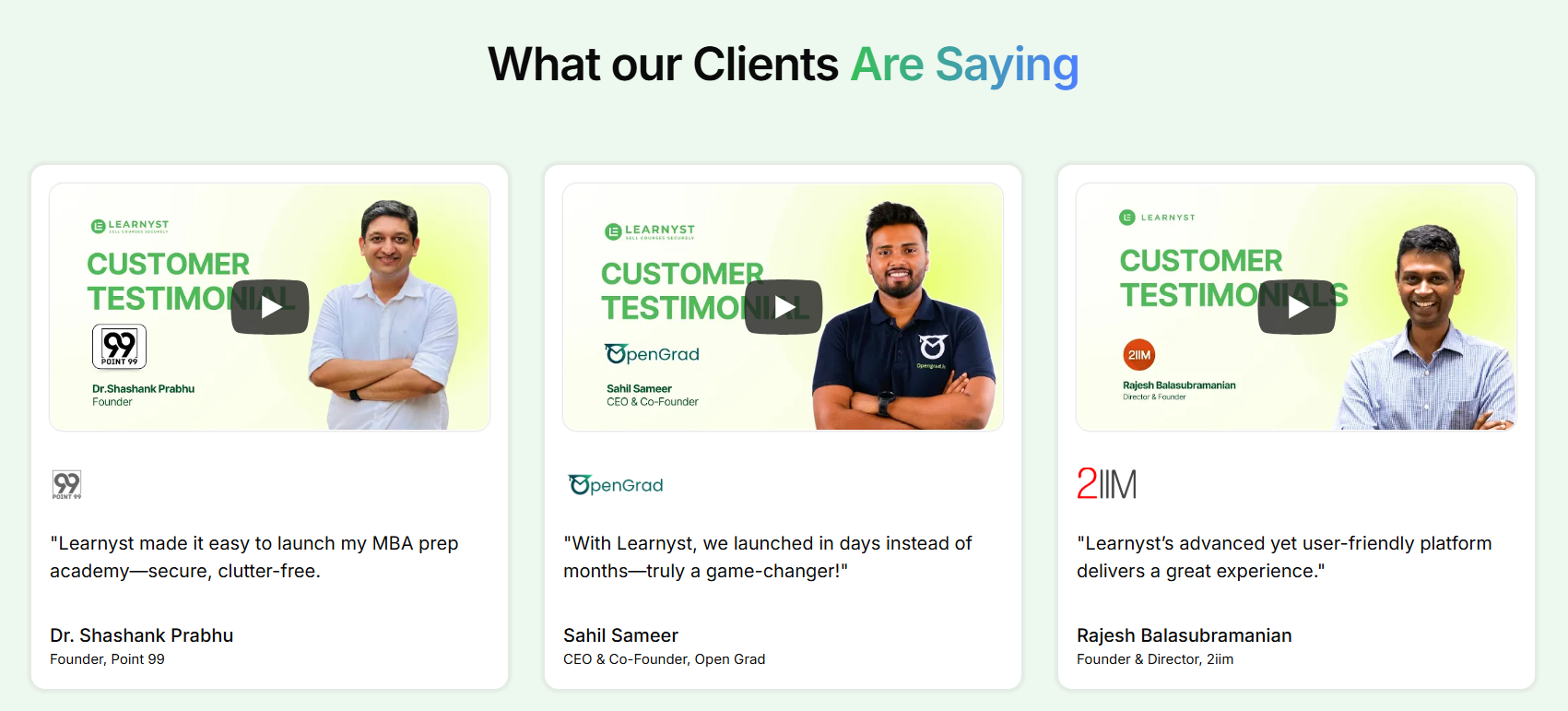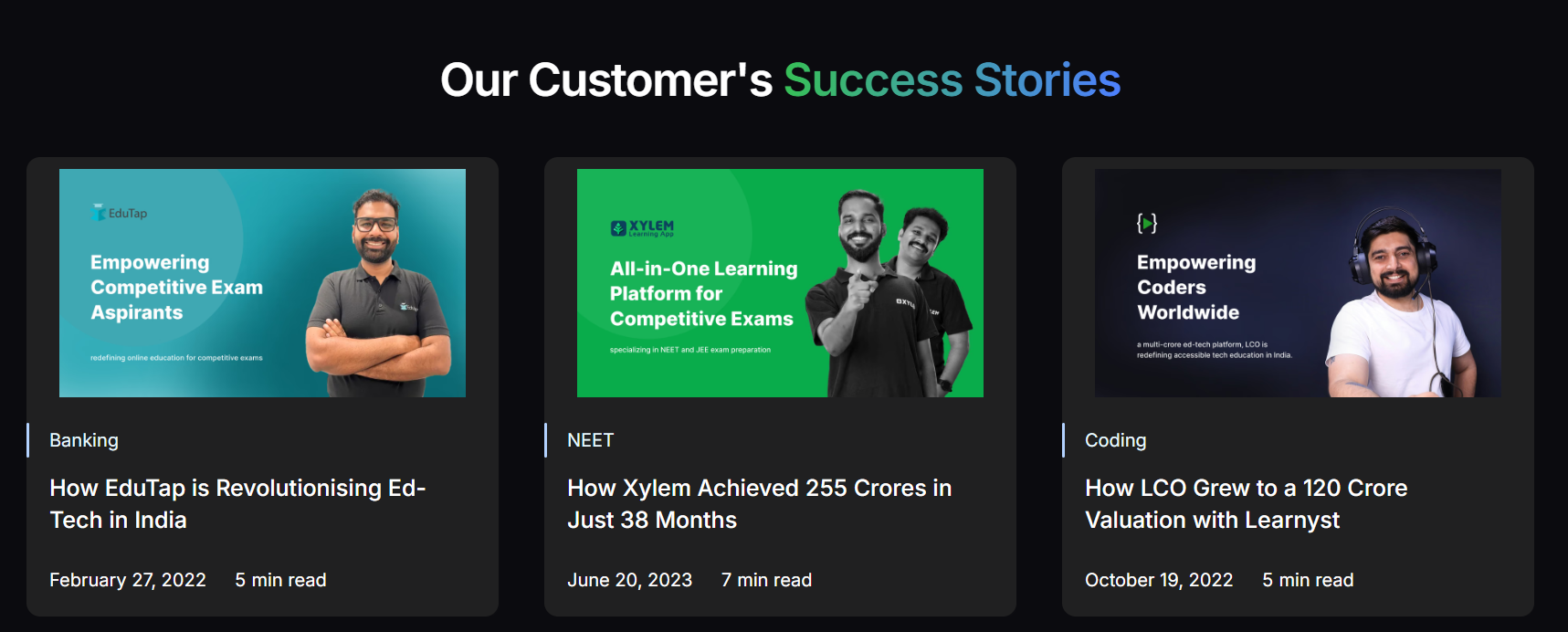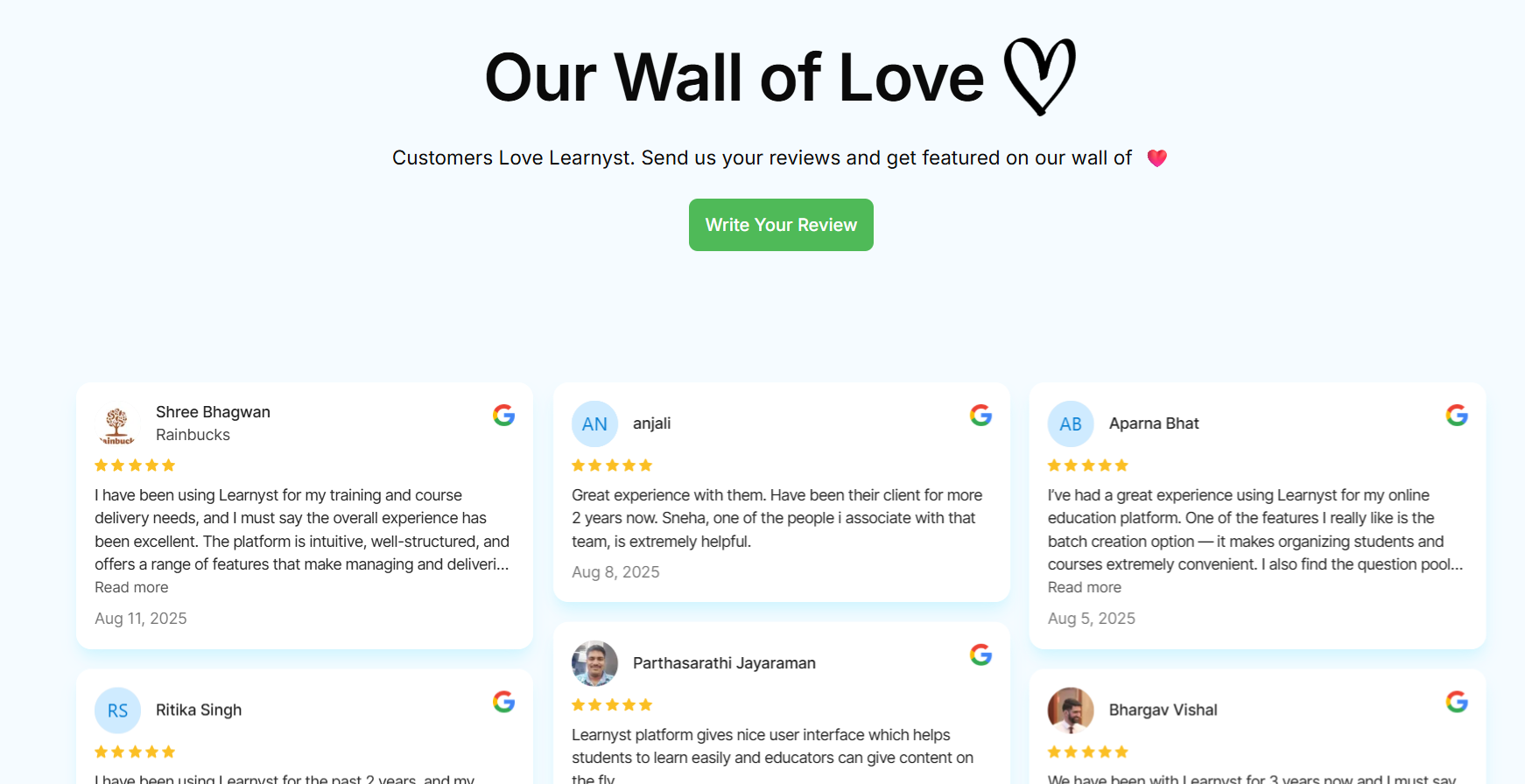Have you ever noticed around you? You don't trust people easily, even when you go to the grocery store where you see a toothpaste that is way cheaper than your regular brand, but still you prefer to buy the same toothpaste that you usually buy.
Why is that? Because you can prefer the offered toothpaste, and you can save some money there. But you still prefer the same toothpaste because you usually don't trust that brand because you've never used it or never heard of it.
The same psychology applies here: you are selling your courses, but still the student doesn't trust easily; that’s where the testimonials come into the picture. Whenever your potential students are browsing through your website, they are not only looking for the pricings, but also they look for real-life experiences that showcase how your teaching is.
So in this study we’ll look into the testimonials, what they are, and how you can utilize them to increase your credibility and trust among your prospective students, which eventually boosts your enrollments.
What are Testimonials?
In simpler terms, testimonials are the written, spoken, or recorded statements of the learning experience they got from your teaching from your past and existing students. It typically includes
- The problems that the learners are facing
- How your teaching or the course helped them
- And what are the positive outcomes that they got?
Why Testimonials Matter
1. Expertise & Trustworthiness
- Testimonials have the real experience that the students get from any particular course, which shows your teaching brings changes and results, which eventually boosts your trust between the learners, which actually got genuine outcomes.
2. Social Proof
- Social proof can be the biggest factor that influences the learners' decision-making. According to the research conducted by Nielsen, 92% of customers trust the recommendations from their family and friends, and 70% of people can trust the reviews that are given by strangers about any product and service.
3. SEO & Conversion Uplift
- The testimonials have the SEO attributes, which are authentic and trustworthy keywords, which answer the learner's question subconsciously and in detail, which can act like a problem solver and boost your SEO reach organically.
According to the survey conducted by BrightLocal, 87% of customers read the online reviews for local businesses, and positive reviews lead to higher conversion rates for your courses.
(Note: link these stats to reputable sources like Nielsen or BrightLocal—ensure you update with exact URLs when publishing.)
Types of Testimonials & How to Use Them
1. Text Testimonials with Photos
Plain texts will become boring when you simply add them to your website, which doesn't fulfill the visual appeal to your prospective learners, so for that you can use those plain texts and add them with the students' photos, which visually shows what a particular student wants to say about your course.
Example: “After I started my teaching journey online with Learnyst LMS, my reach increased, and it made my technical difficulties easy to manage.” – Priya Sharma, Bengaluru, Digital Marketer

2. Video Testimonials
Video testimonial is one of the most important and attractive testimonials for any learner, where the viewer can see the facial expressions and feel the emotions of the genuine beneficiary of your course, which could be a 30- to 90-second clip that showcases any specific benefit the existing learners are getting.
Pro Tip: Encourage your students to mention the challenge that they have faced and how they succeeded before they enrolled in this course, which builds some relativity among the students.

3. Case Studies (Long-form Testimonials)
This might be the lengthy one, so you have to go deeper and on a fully fledged documentation-wise learner's journey. Include context, challenges, actions, and the result that they achieved. Which makes prospective students envision themselves achieving the same outcomes for themselves.

4. Social Media Snippets
Social media is one of the key communication tools and trendy ways of media, so you can embed the students' tweets, Instagram stories, or LinkedIn posts where your learners tag or praise your teaching. These feel genuine and organic to see, which increases the trust among the learners.

Best Practices in Collecting Testimonials
- Timing is key: you can ask for the feedback when your learner completes some milestones, not just at the end. For example, you can ask for the learning experience when your learners finish 1 or 2 modules of their learning or after they achieve their course completion certificate.
- Provide guidance:
Give testimonial templates or prompt questions:
- “What was your biggest challenge before joining this course?”
- “How did the course help you—be specific.”
- “What tangible result did you see?”
- Offer options: Different students have different personalities; likewise, consider all the possible personalities. Some students prefer video testimonials, and some may choose texts, so give them the proper possible option to submit their testimonials.
- Incentivize (appropriately): some students need some more motivation to give testimonials, so give them downloadable resources or free modules or recognition to motivate them to give a proper testimonial, but please keep it ethical.
Strategically Placing Testimonials to Market Your Course
- Homepage or Landing Page: Right near your main headline or call-to-action button to instantly build trust.
- Module Pages: Feature testimonials related specifically to that topic or module.
- Pricing Page: Reinforce value—“Worth every penny”: “the ROI is very good.”
- Checkout or Enrollment Page: A last-minute nudge—“I was nervous at checkout, but…” + positive quote.
- Email Campaigns: Use testimonials in nurture sequences (“Here’s what your senior students experienced…”) to build anticipation.
Examples of Testimonials Done Right
1. MasterClass
-
- Conduct a celebrity teacher or mentor who has a following, and also include the testimonials of students who attended the masterclass and how they benefited, combining star power with social proof.
2. SkillShare
- Uses both video and text testimonials, often showing learner projects before and after.
Boost Your Course Authority with Supporting Content
1. Internal Links (suggestions)
- Link to your written blog or resource pages in your website such as:
- “How to Choose the Right Online Course”
- “Top Success Stories from Our Graduates”
- “Course Curriculum Overview”
2. External Authoritative Sources
- Add links of the reports or the reviews which validate your course outcome claims:
- e.g., LinkedIn Learning Report—the top skills in demand”
- Coursera’s “Working Learner Report”
- Harvard Business Review article on upskilling effectiveness
These add weight to your claims—increasing authoritativeness.
This will add the weightage into your course, which boosts the authenticity and the trust among your learners and prospective learners.
Measuring Testimonial Impact
Measuring your work will give you the outcome that you got after doing the work; likewise, you have to check with the improvement in your course enrollments or the website traffic to see how your testimonials contributed to your growth.
- A/B test placement (e.g., hero section vs. mid-page)—measure click-through rate or enrollment conversions.
- Use tools like Hotjar or Google Analytics to track scroll depth and testimonial interactions.
- Monitor social proof metrics: number of shares, comments, or reactions on testimonial-centric posts.
Common Mistakes to Avoid
- Generic or vague quotes (“Great course!”) — These testimonials will not create the impact, which is not a unique one and which gives a vague idea. So focus on the specific things.
- Lack of authenticity—avoid the stock photos, which are not authorized, and anonymous quotes will have an impact on your trust.
- Overloading pages—avoid adding too many testimonials, which makes readers confused, so select 3 to 5 page views each highlighting a different aspect of the course.
- Ignoring negative feedback—some negative reviews are also important because if you add some negative feedback that doesn't challenge your course quality directly, it will create a sense of transparency for your prospective learner.
Wants to utilize your testimonials?
Collecting the testimonials is possible, but the question is, how will you include them on your website? Not with Learnyst LMS; we give you the feature to embed it into your own website, which will be easy to add and manage your testimonials. And that's not the only thing you can explore in Learnyst LMS; you can create your courses easily, conduct live classes, take tests, and do much more in an instant. So if you are willing to take your teaching to the next level and reach online, then check out our Learnyst LMS today and get 7 days of no-cost trials, which means you don't need to pay for anything.
Testimonials are the most powerful tools that can increase your authenticity and trust with your prospective learners, which is also useful for effective word-of-mouth marketing. They build trust, demonstrate the results, and elevate your credibility.
By gathering authentic and attractive testimonials and adding them into your website strategically, you will make your website more beautiful and attract more traffic and prospective learners into your courses.
A: Quality is more important than quantity. Three to five compelling, varied testimonials that cover a range of learner backgrounds or outcomes are frequently ideal for a landing page.
A: No. Taking money undermines trust. Instead, provide real incentives like a spotlight feature or a free module.
A: Genuine testimonials usually contain real names, photos, and (with consent) complete credentials, but only if necessary for privacy. Be open and honest if you choose to use initials.
.png)






Leave your thought here